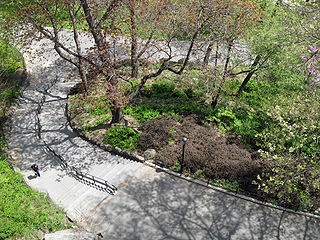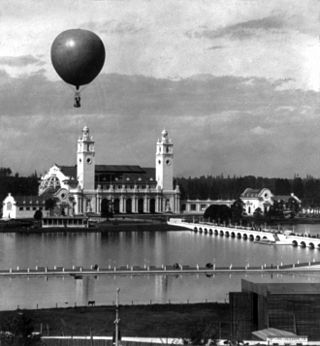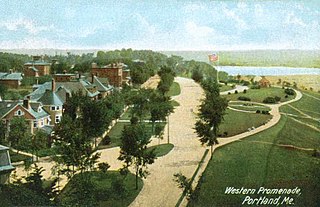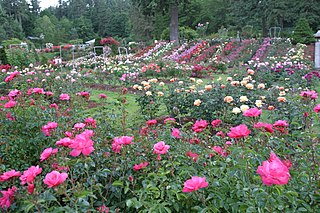
Frederick Law Olmsted was an American landscape architect, journalist, social critic, and public administrator. He is considered to be the father of landscape architecture in the United States. Olmsted was famous for co-designing many well-known urban parks with his partner Calvert Vaux. Olmsted and Vaux's first project was New York's Central Park, which led to many other urban park designs, including Prospect Park in Brooklyn and Cadwalader Park in Trenton, New Jersey and Forest Park. He headed the preeminent landscape architecture and planning consultancy of late 19th century United States, which was carried on and expanded by his sons, Frederick Jr. and John C., under the name Olmsted Brothers.

Volunteer Park is a 48.3-acre (19.5 ha) park in the Capitol Hill neighborhood of Seattle, Washington, United States.

Morningside Park is a 30-acre (12-hectare) public park in Upper Manhattan, New York City. The park is bounded by 110th Street to the south, 123rd Street to the north, Morningside Avenue to the east, and Morningside Drive to the west. A cliff made of Manhattan schist runs through the park and separates Morningside Heights, above the cliff to the west, from Harlem. The park includes other rock outcroppings; a human-made ornamental pond and waterfall; three sculptures; several athletic fields; playgrounds; and an arboretum. Morningside Park is operated by the New York City Department of Parks and Recreation, although the group Friends of Morningside Park helps maintain it.

Governor Tom McCall Waterfront Park is a 36.59-acre (148,100 m2) park located in downtown Portland, Oregon, along the Willamette River. After the 1974 removal of Harbor Drive, a major milestone in the freeway removal movement, the park was opened to the public in 1978. The park covers 13 tax lots and is owned by the City of Portland. The park was renamed in 1984 to honor Tom McCall, the Oregon governor who pledged his support for the beautification of the west bank of the Willamette River—harkening back to the City Beautiful plans at the turn of the century which envisioned parks and greenways along the river. The park is bordered by RiverPlace to the south, the Steel Bridge to the north, Naito Parkway to the west, and Willamette River to the east. In October 2012, Waterfront Park was voted one of America's ten greatest public spaces by the American Planning Association.

The Lewis and Clark Centennial Exposition, commonly also known as the Lewis and Clark Exposition, and officially known as the Lewis and Clark Centennial and American Pacific Exposition and Oriental Fair, was a worldwide exposition held in Portland, Oregon, United States in 1905 to celebrate the centennial of the Lewis and Clark Expedition. While not officially considered a World's Fair by the Bureau of International Expositions, it is often informally described as such; the exposition attracted both exhibits and visitors from around the world. During the exposition's four-month run, it attracted over 1.6 million visitors, and featured exhibits from 21 countries. Portland grew from 161,000 to 270,000 residents between 1905 and 1910, a spurt that has been attributed to the exposition.

Washington Park is a public urban park in Portland in the U.S. state of Oregon. It includes a zoo, forestry museum, arboretum, rose garden, Japanese garden, amphitheatre, memorials, archery range, tennis courts, soccer field, picnic areas, playgrounds, public art and many acres of wild forest with miles of trails.

Washington Park is a neighborhood and public urban park in Denver, Colorado. The Washington Park is a blend of historic and contemporary styles of architecture. The park was first developed by Architect Reinhard Schuetze in 1899. Its design was influenced by city planner Kessler, the Olmsted Brothers and philanthropist Margaret "Molly" Brown. The park is popular with both tourists and area residents, with some comparing it to New York City's Central Park. Apart from activities such as walking, biking or volleyball, the park serves as a center for community gatherings, such as the annual Furry Scurry. Wedding receptions are often held in the historic boathouse pavilion. In 2012 the American Planning Association designated the park one of its “Great Public Spaces in America”.

The Stanford University Arboretum is an arboretum located on the grounds of Stanford University in Stanford, California. It is open to the public daily without charge.

John Charles Olmsted was an American landscape architect. The nephew and adopted son of Frederick Law Olmsted, he worked with his father and his younger brother, Frederick Law Olmsted Jr., in their father's firm. After their father retired, the brothers took over leadership and founded Olmsted Brothers as a landscape design firm. The firm became well known for designing many urban parks, college campuses, and other public places. John Olmsted's body of work from over 40 years as a landscape architect has left its mark on the American urban landscape.

The Great Lawn and Turtle Pond are two connected features of Central Park in Manhattan, New York City, United States. The lawn and pond are located on the site of a former reservoir for the Croton Aqueduct system which was infilled during the early 20th century.

Mount Tabor is an extinct volcanic vent with a city park on the volcano, located in Portland, Oregon's neighborhood of the same name. The name refers to Mount Tabor, Israel. It was named by Plympton Kelly, son of Oregon City pioneer resident Clinton Kelly.

The North Lawn at the White House in Washington, D.C., is bordered on the north by Pennsylvania Avenue with a wide view of the mansion, and is screened by dense plantings on the east from East Executive Drive and the Treasury Building, and on the west from West Executive Drive and the Old Executive Office Building. Because it is bordered by Pennsylvania Avenue, the White House's official street address, the North Lawn is sometimes described as the front lawn.

The South Lawn at the White House in Washington, D.C., is directly south of the house and is bordered on the east by East Executive Drive and the Treasury Building, on the west by West Executive Drive and the Old Executive Office Building, and along its curved southern perimeter by South Executive Drive and a large circular public lawn called The Ellipse.

The 40-Mile Loop is a partially completed greenway trail around and through Portland in the U.S. state of Oregon. It was proposed in 1903 by the Olmsted Brothers architecture firm as part of the development of Forest Park. One greenway expert calls it "one of the most creative and resourceful greenway projects in the country."

Laurelhurst Park is a city park in the neighborhood of Laurelhurst in Portland, Oregon. The 26.81-acre (10.85 ha) park was acquired in 1909 from the estate of former Portland mayor William S. Ladd. The City of Portland purchased the land in 1911, and the following year park superintendent Emanuel Mische designed the park in accordance with the Olmsted Plan.

The Western Promenade is a historic promenade, an 18.1-acre (7.3 ha) public park and recreation area in the West End neighborhood of Portland, Maine. Developed between 1836 and the early 20th century, it is one Portland's oldest preserved spaces, with landscaping by the Olmsted Brothers, who included it in their master plan for the city's parks. The promenade was listed on the National Register of Historic Places in 1989.

Dukes Meadows is a riverside park in Chiswick, London. The land was bought by the council in 1923, and the park was opened in 1926. It is cared for by the Dukes Meadows Trust. The area is home to the Chiswick Farmers' Market, which helps to pay for the park's maintenance. From 2023 the Dukes Meadows Footbridge forms part of the Thames Path.

The plan for a park system in Portland, Oregon, produced by the Olmsted Brothers landscape architecture firm in 1903 served as the model for much of the young U.S. city's development, including neighborhood and regional parks, scenic boulevards, and pedestrian pathways. The Olmsteds were retained by the city's new Park Board, under the guidance of board member Thomas Lamb Eliot. The comprehensive plan was typical of the City Beautiful movement, and was brought to Portland during the run-up to the 1905 Lewis and Clark Centennial Exposition. The report was published as an appendix to the Park Board's annual report on December 31, 1903.

The Park, University of Gloucestershire is a 9.5-hectare (23-acre) community green space in Cheltenham, Gloucestershire.

North Woods and North Meadow are two interconnected features in the northern section of Central Park, New York City, close to the neighborhoods of the Upper West Side and Harlem in Manhattan. The 90-acre (36 ha) North Woods, in the northwestern corner of the park, is a rugged woodland that contains a forest called the Ravine, as well as two water features called the Loch and the Pool. The western portion of the North Woods also includes Great Hill, the third highest point in Central Park. North Meadow, a recreation center and sports complex, is immediately southeast of the North Woods. Completed in the 1860s, North Woods and North Meadow were among the last parts of Central Park to be built.





















